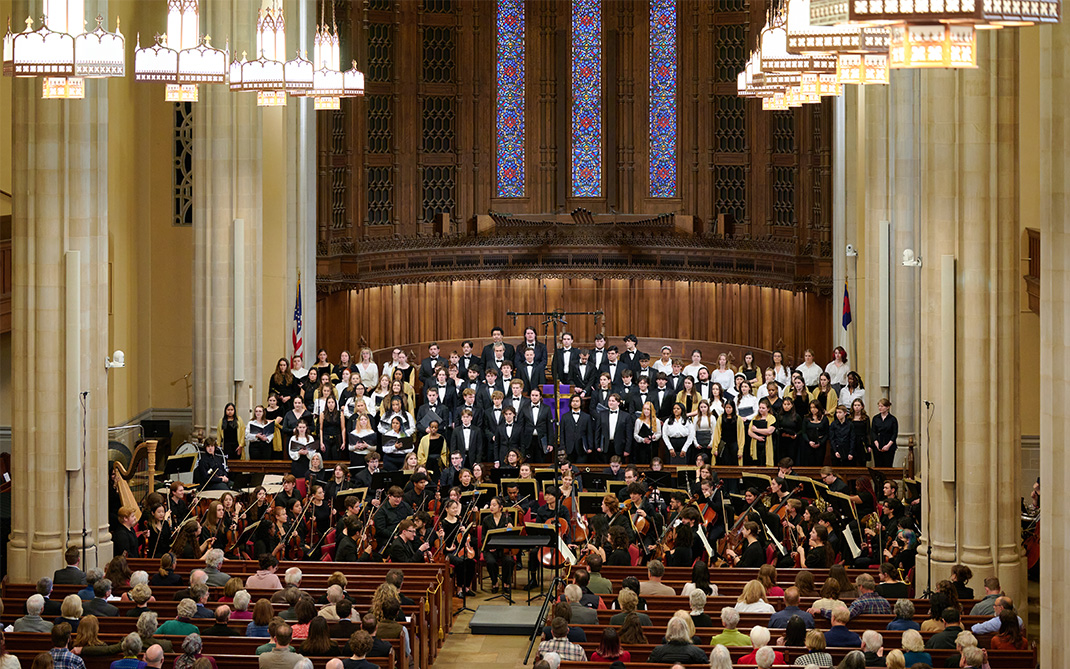UNCSA Filmmaking alumni and staff take center stage as "Oppenheimer" 70mm projectionists
“Oppenheimer” is one of the biggest films of the summer for many reasons, including its star-studded cast and the popularity of the director, Christopher Nolan. But “Oppenheimer” has cinephiles excited for another reason: it is a rare opportunity to view a film projected in 70mm.
Though the format is widely considered the best way to view a film, Nolan is one of only a few directors that films using this iconic filming method. Since it has become an increasingly uncommon way to film, projectionists are also extremely hard to find today…unless you look in the right place. The School of Filmmaking Moving Image Archives (also known as the Film Archives) is one such place – not only is it one of the top ten largest film archives in the world, but it also serves as one of the few places in the country where people can learn the art of film projection and preservation.
Thanks to their experience working with the Film Archives, two staff members and eight alumni are serving as 70 mm projectionists for “Oppenheimer.” Alumni Jesse Price, Adam Witmer, Jonathan Foster, Christopher Schneider, Lucas Taylor, Noelle Aleman, Scott DuVall and Jason Garnett were all trained by the staff at the Film Archives during their time as students. Additionally, staff members Matt Jones and Eric Self are practicing what they teach by serving as projectionists.
'Destroyer of Worlds'
Based on the true story of theoretical physicist J. Robert Oppenheimer, “Oppenheimer” focuses on the titular character's experience during World War II. During that time, Oppenheimer served as the director of the Manhattan Project’s Los Alamos Laboratory, where the first nuclear weapons were developed.
Starring many well-known actors, including Cillian Murphy, Emily Blunt, Florence Pugh, Robert Downey Jr. and Matt Damon, “Oppenheimer” has already earned over $400 million globally. In addition to the lead cast members, three School of Drama alumni can be seen in the film in notable roles; Dylan Arnold (B.F.A. ‘16) plays Frank Oppenheimer, younger brother of J. Robert Oppenheimer, Steve Coulter (B.F.A. '81) plays American chemist James Conant, and Dane DeHaan (B.F.A. ‘07) plays Kenneth Nichols, a civil engineer in the Army who worked on the Manhattan Project.

School of Drama alumnus Dylan Arnold (left) in "Oppenheimer" as Frank Oppenheimer.
Arnold spoke with the Hollywood Reporter about his experience on set and watching the crew work together. "It was a pretty amazing experience to watch [Director of Photography] Hoyte van Hoytema hoist that massive 80-pound camera on his shoulder with ease and then reload that giant IMAX mag,” explains Arnold. “It’s also little moments like that where you just look around and think, 'Everyone is so on it. Everyone just knows so much. Top to bottom, this is an extraordinary experience.'"
Signature filmmaking style
Director Christopher Nolan is known for his complex storytelling and is largely considered one of the best filmmakers of the 21st century. While this can be partially attributed to his unique cinematic style that explores themes around reality, another part is because Nolan prefers shooting in 65mm film, also known as premium large format film stock. The film is then projected in IMAX 70mm film and the extra 5mm is used for sound.
Nolan explains that he was very intentional with the decision to film “Oppenheimer” in premium large format. “We put a lot of effort into shooting the film in a way that we can get it out on these large format screens,” he told the Associated Press. “It really is just a great way of giving people an experience that they can’t possibly get in the home.”
Many of Nolan’s award-winning films, including “Inception,” “Interstellar,” “Tenet” and “Dunkirk,” were either partially or fully filmed on 65mm film. It is a format he started using during “The Dark Knight” and has now become one of his signatures. “The sharpness and the clarity and the depth of the image is unparalleled,” Nolan tells AP. “You’re getting a feeling of 3D without the glasses. You’ve got a huge screen and you’re filling the peripheral vision of the audience. You’re immersing them in the world of the film.”
The 70mm difference
Historically, a majority of films were filmed on 35mm, and 70mm was reserved for blockbusters like “Oklahoma!,” “Ben-Hur,” “My Fair Lady” and “2001: A Space Odyssey.” However, with the rise of digital filming methods, both physical film formats have dwindled over the past 15 years.
Alumnus Adam Witmer (B.F.A. ‘16) elaborates on why 70mm projection is still very relevant and important in filmmaking. “70mm is still the best image quality you can see on the screen,” he says. Though several factors make this so, he summarizes that the most important reasons are “resolution, brightness and color.”
“As opposed to digital methods, film’s image isn’t made up of pixels so you can zoom in and still have a very sharp image,” explains Witmer. “Additionally, when watching a digital projector, whenever you have a screen that’s dark, there will still be a slight glow because the projector is sending light. Due to the way 70mm or 35mm film blocks light during dark scenes, it’s actually black so that the theater will be completely dark.” He adds that the inverse is also true, “true white is clearer and brighter on film because the lamps tend to be brighter than most digital projectors.”
70mm is still the best image quality you can see on the screen.
Adam Witmer, Film Alumnus
Matt Jones, who currently serves as the associate curator of the Film Archives, adds that when comparing digital projection and 70mm projection side-by-side, “it's not even close.”
“When you watch film, you spend half of your time in the dark as the shutter opens and closes 24 times per second. It's an active process for the brain as it tries to make sense of what it's seeing. It's why you often rub your eyes from the strain as you leave a film show,” explains Jones. “Digital content, on the other hand, uses scan lines to replace a previous image with a new one and never goes dark. It has a numbing effect on the brain, which is why you're more likely to zone out and fall asleep when watching TV on your couch.” Jones believes that by returning film to theatres, “audiences can again enjoy the active process it used to be – nowadays there's very few opportunities for the general public to do that.”
So, if it is superior to other filming methods, why isn’t 65mm standard? Mostly it comes down to cost, availability of equipment and ease of transportation. It is very expensive to shoot. Since nearly all theaters only project digitally, distributing a film and finding projectionists to run it is a huge ordeal. Additionally, the film is challenging to transport – just one copy of 70mm film for “Oppenheimer” weighs 600 pounds.
Despite these obstacles, Dean of Filmmaking Deborah LaVine believes the format isn’t likely to disappear. “Filmmakers the caliber of Martin Scorsese and Christopher Nolan have long been demanding higher standards in the projection of contemporary and historical films. Scorsese explains that the audience ‘misses the narrative. You’re missing the performance’ when watching subpar projection.” Thankfully, there are schools like UNCSA that are still teaching the necessary skills these imaginative filmmakers need.
A hidden gem
Tucked into the School of Filmmaking campus lives the Film Archives building, the fifth largest non-commercial archive in the country. The extensive holding includes a collection of 16,500 original feature film prints on 70mm, 35mm and 16mm; 240 live-action and animated short films, documentaries and newsreels on 35mm and 16mm; 4,600 previews of coming attractions on 35mm; and over 20,000 videocassette, laserdisc and DVD titles.
At the Film Archives, students can either volunteer or do work-study as they start at the bottom and work their way up, learning about all aspects of caring for and handling the various pieces of media housed there. Witmer was a work-study student in the Archives for all four years he was at UNCSA and says that he and any other student trained by the staff had to first prove they could be trusted before they were taught to become a projectionist. “My first year was hauling inventory around, second year I was taught to inspect the films, and by the third year Matt felt I was ready to learn how to become a projectionist,” explains Witmer.

A look inside the School of Filmmaking Moving Image Archives (also known as the Film Archives).
LaVine emphasizes how crucial it is for a projectionist to be highly skilled. “The art of film projection is very demanding and requires great skills, not the least of which are receiving and checking film reels, loading the films onto the projector in the right order, making sure the film runs smoothly through the projector, checking that sound is operating properly, joining ('splicing') lengths of film together if they break. A projectionist must have a terrific sense of color, hearing and timing.”
The archives are run by Matt Jones and Eric Self, who are dedicated to maintaining the inventory, training students and managing the free films that are screened every weekend at the ACE Theater.
Jones explains his philosophy for approaching his job at the Moving Image Archives. “When I started at UNCSA over 20 years ago, I decided that I wanted to show as many people as possible as many different kinds of film as possible because there's secrets to life in art if you look at it the right way.”
He adds that seeing countless students graduate and move on to their careers in the film industry, Jones still finds joy in the mentorship aspect of his job. “These jobs are hard, very hard, and I can't say how proud I am to watch our students step up to the plate over and over.”
Now, from St. Louis to Los Angeles, our alumni and staff are currently utilizing skills learned at UNCSA to project “Oppenheimer” for movie lovers nationwide. Though there are only 30 theaters that are currently screening in 70mm, people are traveling long distances to experience the film the way the filmmaker intended.
Get the best news, performance and alumni stories from UNCSA.
SUBSCRIBE TO OUR NEWSLETTERS(OPENS IN NEW TAB)(OPENS IN NEW TAB)(OPENS IN NEW TAB)(OPENS IN NEW TAB)(OPENS IN NEW TAB)(OPENS IN NEW TAB)(OPENS IN NEW TAB)(OPENS IN NEW TAB)(OPENS IN NEW TAB)(OPENS IN NEW TAB)(OPENS IN NEW TAB)(OPENS IN NEW TAB)(OPENS IN NEW TAB)
August 02, 2023




